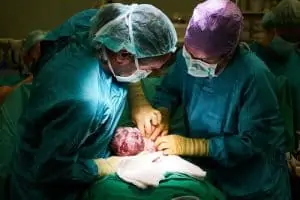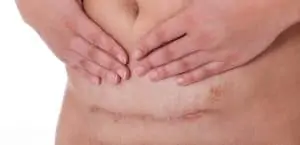Before and after major surgery, doctors set a limit on when you can eat. Most women need to remain in the hospital for 2-3 days after a c-section, and you might wonder when you can eat after a c-section.
When I had my four c-sections, I received instructions to stop eating at midnight before my surgery. So, by the time my c-section rolled around, I started feeling hungry. Then, I knew I couldn’t eat immediately after the surgery.
Ravenous couldn’t describe how I felt!
So, I had to figure out the standard procedure for eating after a c-section. You might be wondering the same thing, so here is what you need to know.
When Can You Eat After a C-Section?
In most circumstances, you will be asked to wait 6-8 hours after your c-section to start eating. You can eat ice chips or take sips of water before this time, but your doctor needs to be sure that your bowel system works correctly after surgery.
Eating solid foods after your cesarean section might help to reduce how much time you spend in the hospital. We always feel better when we are eating a healthy diet. It gives us the strength and energy needed to move, and you need that with a newborn baby. Also, eating can help to relieve constipation, primarily if you focus on eating fiber-rich foods.
One study indicated that women offered solid foods within eight hours after their surgery faced a shorter hospital stay. It also showed that these women experienced a quicker return to bowel function.
In my case, my doctors wanted me to pass gas before I could eat. That typically happened around the time that I was able to walk after surgery and have my catheter removed. Once you can get up and go to the bathroom, you should be able to pass gas comfortably.
Usually, you’re not moved directly to french fries and hamburgers straight after birth. Instead, you have a liquid diet. That means you can eat things such as:
- Chicken broth
- Jello
- Fruit juices
- Fruit popsicles
- Ice Cream
- Sherbert
- Yogurt
- Cream of Wheat
- Applesauce
Why Do Doctors Delay Eating Solid Foods?
There are several reasons. As you might imagine, surgery is a doozy for your intestines. It can disrupt your digestive system, and it needs time to get to work again.
Also, you’re given a range of medications following your c-section to help relieve the pain from the surgery. Sometimes, you might have issues with pain medication. You might experience nausea, an upset stomach, or vomiting from the drug.
Puking right after abdominal surgery is dangerous. It can be excruciating, and you risk breaking open your incision from the force of vomiting.
This is important:
One thing you can do is gently walk frequently as soon as possible. Walking improves circulation and gets your digestive tract working the way that it should. You should expect it to take several days to have a bowel movement. Narcotics can lead to constipation, which can last several days.
Eating Well After a C-Section Matters
The delivery of a baby takes a lot out of your body, so eating well after you have your baby helps you heal faster. Also, if you decide to breastfeed your baby, you need to ensure you’re getting all the proper nutrients so that it doesn’t pull from your reserves.
Your body will provide all the vitamins your baby needs through breast milk, but if you don’t take in those nutrients (and enough of them), it pulls from your body. That means you might end up with calcium or vitamin C deficiency if you fail to eat properly.
Also, you need to take in 400-500 extra calories each day while you breastfeed. Breastfeeding burns calories, which is pretty cool!
Not to mention, you want to have some energy after the delivery of your baby. Eating properly gives you the energy you need while also helping you lose the baby weight faster.
What Should You Eat After a C-Section?
Once you leave your full liquid diet behind, that doesn’t mean you should eat whatever you want to eat. Eating the right foods can help the first bowel movement be less uncomfortable, and certain foods can reduce any nausea you might experience.
After a c-section, it’s best to focus on eating a balanced diet of whole foods. You should include fresh fruits and vegetables, whole grains, dairy, and protein sources.
Protein & Calcium Foods
Adding protein and calcium to your diet is vital. Protein quickens the healing process after delivery while repairing tissues. Calcium strengthens your bones and teeth. Your body sends 250-350 mg of calcium to your baby.
Try adding some of these foods to your diet.
- Lean meats
- Milk
- Yogurt
- Cheese
- Beans
- Sesame Seeds
Whole Grain Foods
Whole grains always deserve a place in your diet because they’re rich in carbohydrates, which help you keep up your energy levels and breast milk production. If you buy foods with enriched whole grains, they’ll also have iron and folic acid.
Add these foods to your diet.
- Pasta
- Brown Bread
- Brown Rice
Fresh Fruits & Veggies

You can never eat too many fresh fruits and vegetables! They’re full of vitamins and antioxidants that our body needs to repair the tissues. Also, vitamins encourage your body to create collagen, which builds up new skin and scar tissue. That’s exactly what your body needs after surgery!
Here are some fresh fruits and veggies to add to your diet.
- Apples
- Broccoli
- Spinach
- Grapefruits
- Watermelons
- Bananas
- Carrots
- Mushrooms
- Blueberries
Fiber-Rich Foods
Constipation is a big deal during the postpartum phase and can cause unnecessary pressure on your wounds and incisions. Plus, your first few bowel movements will feel like giving birth again. You can help avert some of this constipation by eating more fiber-rich foods.
- Raw fruits and vegetables
- Oats
- Lentils
- Nuts
- Dried Beans
Iron-Rich Foods
Iron is necessary to maintain your hemoglobin levels and restore blood loss during the c-section. It’s also vital for proper immune system functioning. Women need to intake 9 mg of iron daily; anemia is common for women, especially after childbirth.
Try eating these foods:
- Egg yolks
- Red Meat
- Spinach
- Dark Leafy Greens
- Oysters
- Beef Liver
- Dried Fruits
Foods to Avoid After a C-Section
While there are so many great foods that you should eat after your surgery, there are a few foods that you should avoid as much as possible. For example, you should avoid fatty and junk foods because your physical activity is low after your c-section, and you might gain weight.
Here are a few other examples of foods you should eat.
- Spicy foods that might lead to stomach problems
- Carbonated drinks
- Citrus juices
- Onions and garlic might cause gas
- Tomato juice
Fluids Matter A Lot
Drinking fluids is an integral part of your recovery and is most important in the hours following your c-section. Pushing fluids is crucial because it can help relieve constipation and other bowel problems.

Fluids can keep you hydrated and help you establish a proper milk supply for your newborn baby — plan to drink at least eight 8-ounce cups of water daily. You also can drink some juice or decaffeinated hot tea.
Make sure you avoid drinking caffeine, which can lead to excessive urination, irritability, and a loss of bodily fluid. Also, all of the carbonation in the soda can cause excess gas in your stomach. You don’t need more gas in your system; that leads to more pain than you need.
5 Tips for Eating After a C-Section
Here are some simple tips to help improve your diet after having your baby!
Have Several Smaller Meals
Instead of aiming for three big meals daily, plan to eat several smaller meals. Plus, if you’re breastfeeding, you’ll get hungrier quicker. You can have breakfast, lunch, and dinner, but make the portions smaller and toss a few healthy snacks throughout the day.
Eat Slowly
Your first instinct will be to eat fast because who knows how long your baby will stay asleep but eating too quickly can lead to excess gas and bloating. The last thing you want is to feel bloated with your incision!
Pick Nutrient Dense Foods
Now is the best time to pick the best foods for yourself. Don’t reach for fried and greasy foods. You want to pick vegetables, fruits, and all of the foods we listed above. Instead of eating chips for a snack, try some nuts and dried fruits. If you need to munch, grab an apple with peanut butter instead of a Hot Pocket from the freezer.
Stay Hydrated
Don’t forget how important staying hydrated is for your recovery and breastfeeding. You want to drink between 8-12 cups of water each day. That’s particularly important if you’re breastfeeding! Water is the best, but you can drink other fluid sources if you need to switch it up. Plus, the more you drink, the less likely you are to become constipated.
Eat Plenty of Fiber
Your goal should be to eat at least 25 grams of fiber daily. That should come from various sources, such as fresh fruits and vegetables, whole grains, beans, and more. The more fiber you eat, the easier your time in the bathroom will be.
Eat After a C-Section When You’re Ready
Research shows us that eating solid foods after a c-section is safe and helps with recovery; you might not be ready just yet. Feeling nauseous or having digestive issues could make eating food difficult and even more uncomfortable.
Follow your doctor’s recommendations and your instincts. Your doctor might tell you that it’s time to eat, but if you feel nauseous, it might be best to wait until your body says it’s ready. You can always eat a glass of hot tea until it passes.
Hey, this is Linda. My biggest accomplishment in life is being a mother of four children. Their current ages range from almost ten years old down to 20 months old.
I’m passionate about writing parenting articles because I understand so well all of the problems and trials you face as a parent. From breastfeeding woes to budgeting problems and behavior problems, along with everything in between, chances are I’ve faced it over the last ten years. Read more about Linda here.






